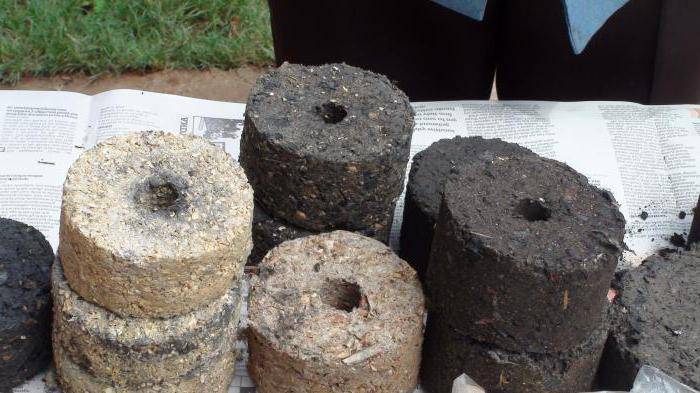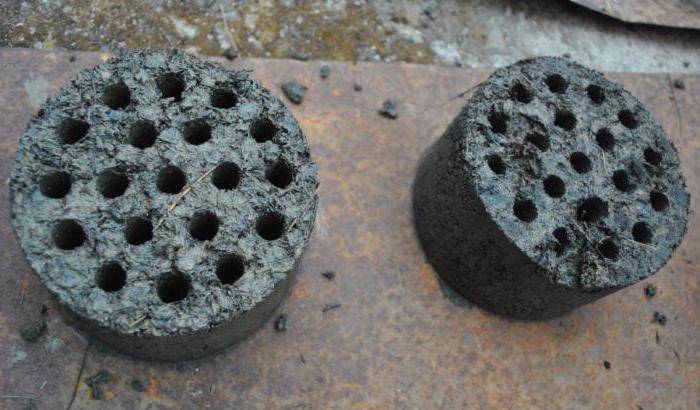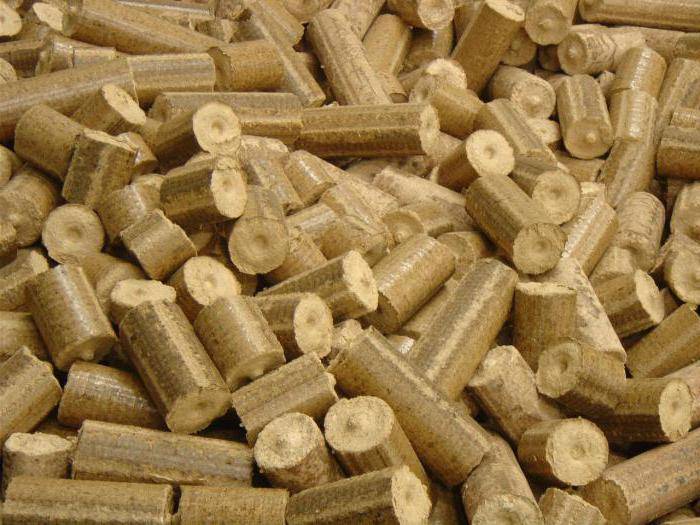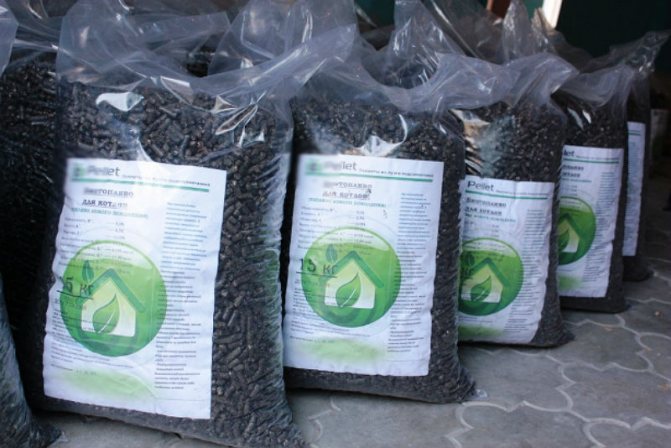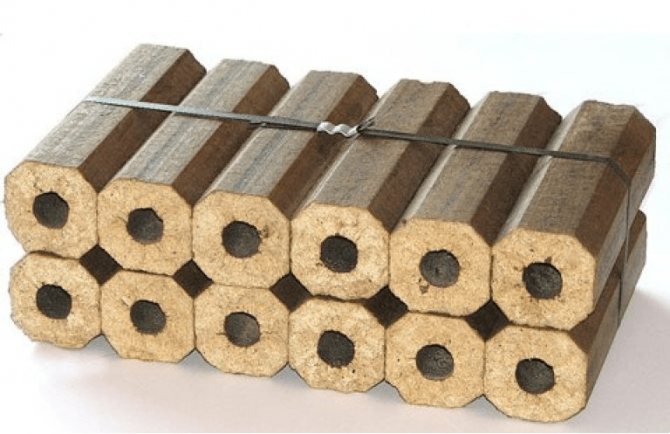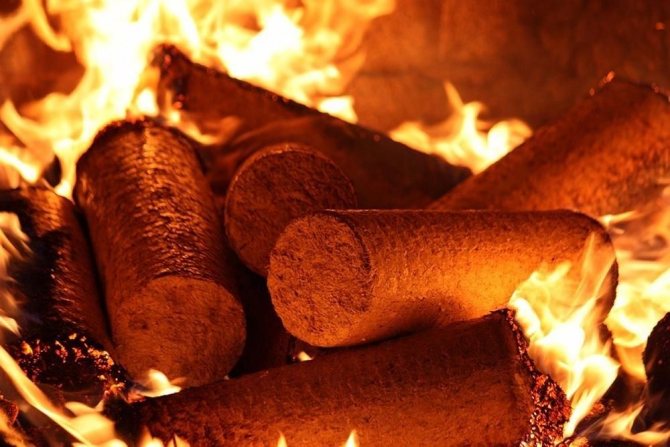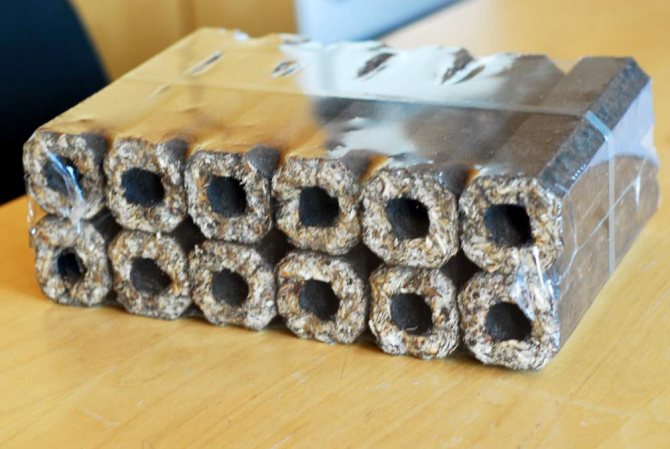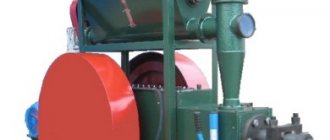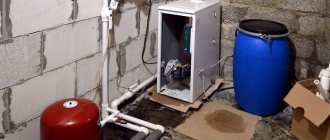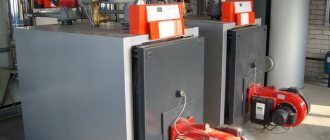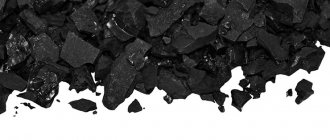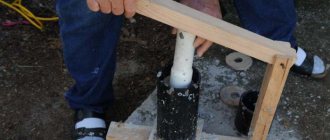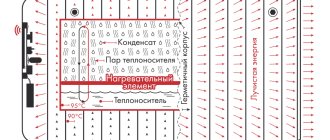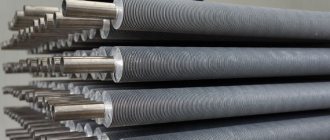This amount in various oil factories can reach tens of tons per week.
Hull disposal has always been a problem: due to the low bulk density, transporting waste to landfill is expensive. During storage, it can easily ignite and smolder, spreading an unpleasant odor. A certain amount of it is used as fertilizer and for loosening the soil.
However, sunflower husks have such an invaluable property as high calorific value on combustion
... It is this quality that makes it one of the most efficient types of fuel, which is produced in the form
fuel briquettes and granules (pellets)
... Granulation is one of the most common methods of processing husk, as a result of which the moisture content of the product is reached up to 12% and the compression of the initial volume is 5-10 times.

Burning time reviews


If you decide to purchase fuel briquettes, it is recommended to read reviews about them even before going to the store. It is important to take into account that these products, as noted by consumers, are characterized by a significant burning time, which is especially evident when compared with traditional firewood. Thus, laying in heating equipment can be done 3 times less often. Combustion occurs with minimal smoke generation, material does not spark or fire. In this case, it is noted that a constant temperature is ensured throughout the entire combustion period. After combustion, coal is formed, which is also true for ordinary firewood. In the future, the combustion product can be used for grilling or cooking kebabs.
Comparative characteristics of briquettes
Each type of briquettes has its own characteristics and advantages. And although they are all great for heating in a domestic environment, it is still worthwhile to familiarize yourself with their characteristics in more detail. to choose the best option.


Forms of fuel briquettes
Wood briquettes
This type of briquettes is obtained by pressing various wood waste - dead wood, sawdust, shavings, substandard wood. Before pressing, the waste is heated to a certain temperature, as a result of which an adhesive substance, lignin, is released from the cells. Thanks to lignin, briquettes acquire high strength and retain their shape during transportation and storage.
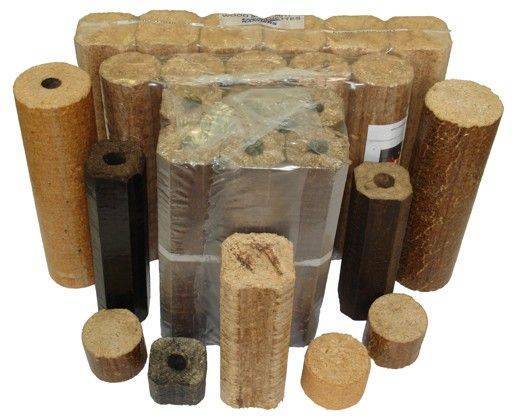

The advantages of briquettes over solid wood are obvious:
- the density of briquettes is constant and amounts to 1240 kg / m³, the density of wood depends on the species and ranges from 150 to 1280 kg / m³;
- the maximum moisture content of briquettes is 10%, of wood - from 20 to 60%;
- when briquette is burned, the ash volume is equal to 1% of the total mass, wood - 5%;
- when burning, briquettes release 4400 kcal / kg, wood - 2930 kcal / kg.


In addition, wood briquettes have other advantages:
- pressed wood does not spark during combustion and emits very little smoke;
- the boiler is kept at a constant temperature;
- briquette burning time 4 hours;
- the coals remaining after combustion are great for cooking over an open fire;
- the correct shape of the briquettes simplifies their transportation and storage.
Such fuel is sold not in cubic meters, like wood, but in kilograms, which is much more profitable.
Coal briquettes
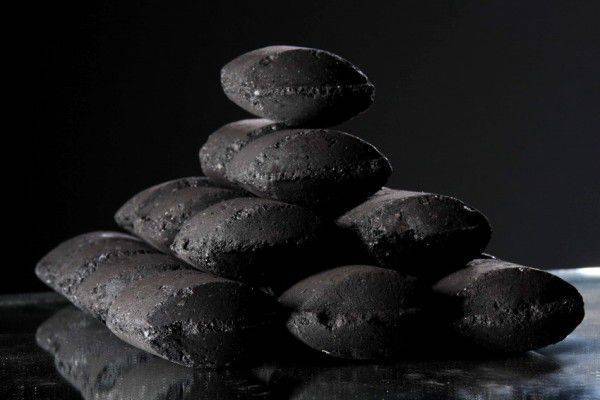

This type of briquettes is obtained from the screening of coal. First, the screenings are crushed, mixed with a binder, and then compressed under high pressure.
The main properties of such fuel:
- coal briquettes do not smoke;
- do not emit carbon monoxide;
- burning time in conventional boilers from 5 to 7 hours, with controlled air supply - 10 hours;
- suitable for domestic use;
- have a compact shape;
- when burning, they emit 5200k / cal and maintain a constant temperature;
- maximum ash volume - 28%;
- have a long shelf life.
Coal briquettes are the most optimal fuel in harsh winters, when pressure drops in domestic gas systems due to low temperatures. Briquettes burn at any temperature, the main thing is that there is a constant flow of air.
Peat briquettes


To make briquettes, peat is dried, heated and pressed under high pressure. The result is neat lightweight bricks of a dark color. With controlled air supply, peat briquettes maintain the temperature for 10 hours, which is very convenient for heating the house at night.
- suitable for all types of ovens;
- heat transfer is equal to 5500-5700 kcal / kg;
- ash volume 1% of the total briquette volume;
- affordable price;
- the minimum amount of impurities in the composition.
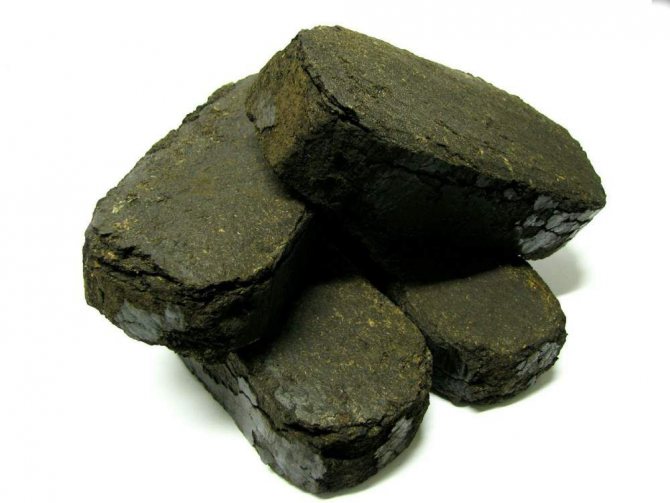

The ash that remains after fuel combustion can be used as an effective lime and phosphorus fertilizer. For many owners of private households, this factor is decisive when choosing heating briquettes. Since peat is a flammable substance, it should be stored at a safe distance from open flames and heating appliances. Even dust that has spilled out of the packaging can ignite and cause a fire, so you need to handle the briquettes correctly.
Hull briquettes


Hull briquettes
Sunflower husks, buckwheat and rice husks, rye, oats and even straw are widely used for the manufacture of fuel briquettes. The most common are sunflower husk briquettes, since a large percentage of waste remains in the production of oil. The maximum moisture content of the husk for pressing is 8%, which increases heat transfer and shortens the ignition time.
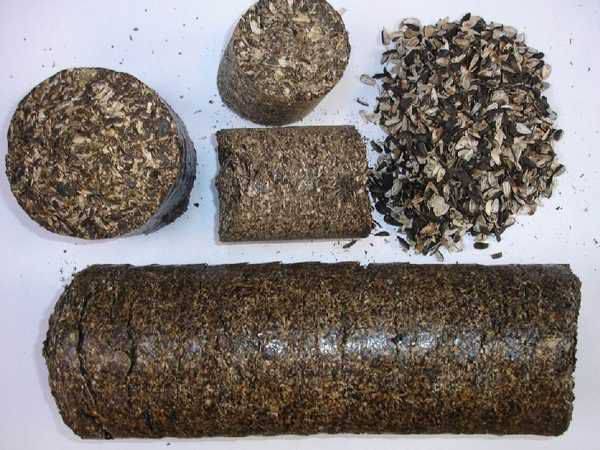

Sunflower briquettes
- the density of briquettes is 1.2 t / m³;
- heat transfer - 5200 kcal / kg;
- ash volume from 2.7 to 4.5%.
- lack of harmful impurities;
- affordable price;
- long burning time;
- convenience of storage and transportation.
Calorific value reviews


Buyers choose fuel briquettes from sunflower husks, reviews of which you can read in the article, for the reason that their calorific value is much higher compared to ordinary firewood. Practice shows that the mentioned parameter is equal to that of coal. Barbecue lovers and grill owners emphasize that when fat gets on the coals formed after the combustion of briquettes, no ignition occurs, the material continues to burn or smolder with a low, even flame. It should be noted that the temperature is constant. Heat transfer is 4400 kcal.
Equipment for the production of briquette from husk seeds
The technology for manufacturing fuel briquettes from biomass (which includes the husks of sunflower, rice, buckwheat, etc.) is as follows:
- Raw materials are washed and dried.
- Grind.
- Compressed.
- Cool down.
- Pack.
The equipment is selected accordingly. You will need a dryer and a crusher (hammer or shredder), but most importantly - a press (piston, extrusion or screw). Funds may also be needed to transport raw materials and finished products to the workshop, a cooling unit and packaging equipment.
Environmental friendliness reviews
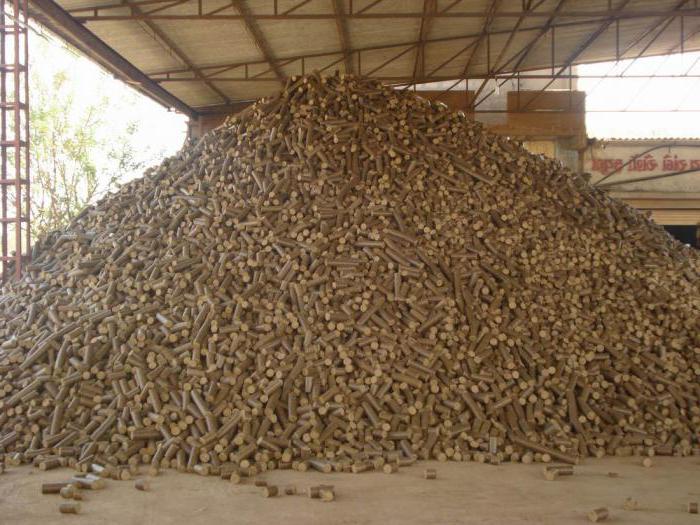

Fuel briquettes from sunflower husk, reviews of which you should be interested in before purchasing, are environmentally friendly. It is this characteristic, according to buyers, that largely determines the choice towards the described fuel. During production, all kinds of additives are not used, and during combustion, no harmful substances are released into the environment, this is especially true if we compare it with solid fuel with the same calorific value as coal.Ultimately, coal can even be used as a mineral fertilizer.
How to make a press for self-production of briquettes
It is hardly possible to make your own equipment for the production of fuel briquettes using extrusion (pressing at high temperatures), but an ordinary press can be built even from improvised means.
This video demonstrates an original approach. Making such a press is not the most difficult task, and the product yield from one tab is decent. It can be easily adapted for pressing sunflower husks, only it will need to be crushed first.
In general, our people are generous with all sorts of inventions. The culture of implementation is different for everyone, but whoever can do so. Here is a selection of photos, which also show homemade presses for making fuel briquettes, including those from sunflower husks.
Fuel husk briquettes - as a substitute for coal
Reviews of sunflower husk briquettes


Fuel briquettes from sunflower husks, reviews of which will help you make the right choice, have a lot of advantages. According to the European classification, such briquettes can be classified as smoke-free fuels. This attracts owners of fireplaces and heating equipment installed inside the house. Consumers choose these products also for the reason that they are very compact, which is important not only for a private, but also for a small country house. Among other things, oversized fuel is very convenient to transport, it is easy to load and unload it, and you do not have to pay too much for transport services. Fuel briquettes, reviews of which you will know after reading the article, are suitable for cooking any food in barbecues, barbecues and grills. Due to the fact that no carbon monoxide is emitted during the process, cooking can be done inside enclosed spaces, as concerns not only a residential building, but also a veranda, restaurant or cafe.
Benefits of Coal Briquettes
Increasingly, coal briquettes are used for heating not only in homes, but also in metallurgical and chemical plants, power plants, and boiler houses. They are made by crushing coal into small fractions (up to 6 cm). Then the prepared raw material is mixed with the addition of a binder. With the help of hot steam and a press, briquettes are formed and sent to a special container for cooling.
Quality depends not only on the raw materials and adherence to the technological chain, but also on the binder component. In the manufacture of coal blocks for industrial use, binders such as coal tar, cement, petroleum bitumen, and water glass can be added. For household purposes, there are starches, molasses, less often gypsum or lime.
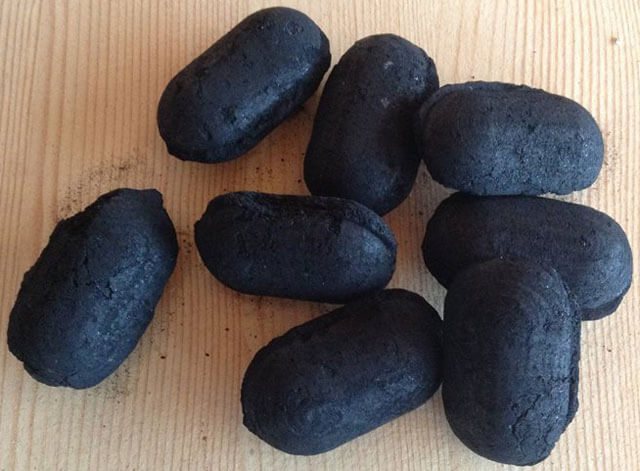

Of all fuels, only coal does not produce smoke when burned. Briquette fuel based on coal can burn continuously for about seven hours if the air supply to the heating compartment is adjusted. As a rule, it is required to load a new batch of briquettes into the oven no more than three times during the day in order to maintain a normal temperature regime in the house.
Advantages of coal briquettes:
- long burning;
- high efficiency (95%);
- low percentage of ash yield (no more than 1%);
- less carbon dioxide emitted than when using peat and wood;
- convenient loading into the firebox.
In very cold winters, charcoal in briquettes for the stove is guaranteed to provide long-term stable heat. Practice has shown that it is very convenient to use coal blocks for heating greenhouses and outbuildings.
Reviews of reed briquettes
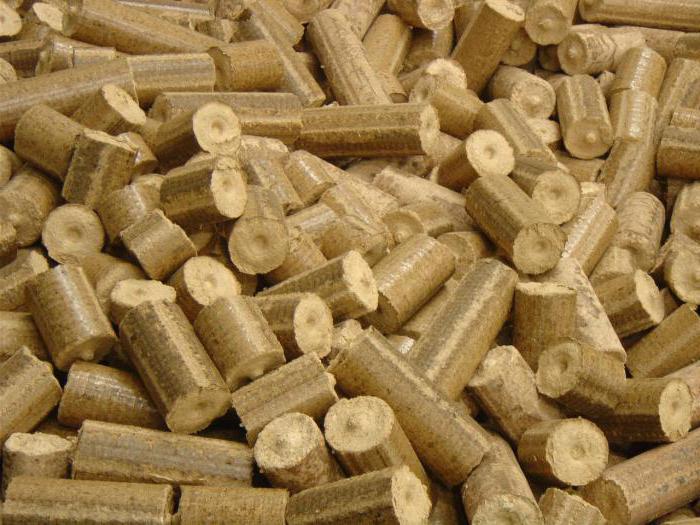

If you are interested in reed fuel briquettes - who burned, reviews, etc.information - you can read all this below. Buyers claim that 1 kilogram of material will be enough for 7 hours of continuous burning. In this case, the heat transfer will be 6550 kcal / kg. Owners of boiler equipment say that the device will have to be cleaned only once every two years. The resulting ash, like coal, can be used as an environmentally friendly fertilizer.
You can ensure autonomy by using this type of fuel, since the equipment will not depend on the companies supplying electricity and gas. There is no dependence on external conditions such as damage to pipelines, power lines, theft, etc. Consumers do not face the need for long-term approval, which is carried out before connecting electrical or gas equipment.
Reed fuel briquettes, reviews of which resonate with positive characteristics, have a high density. In the production process, a technology is used that involves screw pressing. As a result, it is possible to achieve a density in the range from 1.1 to 1.2 t / m3. The surface consists of a sufficiently strong crust, which excludes damage and rupture of the briquette during transportation and storage. Transportation can be carried out by laying the products in two tiers, since the material almost does not form crumbs. The existing crust is able to reduce the penetration of moisture inside, which makes the use of briquettes more comfortable.
Advantages and disadvantages of husk briquettes
In addition to a large amount of heat, briquettes are attracted by their density. Why is it so good? Firstly, you save on shipping (the fee is usually charged per volume). Second, the more compact the fuel, the easier it is to store. Thirdly, if we compare it with firewood, then when laying the same amount of firewood and briquettes (you are unlikely to measure firewood in kilograms, because they lay a boiler by volume, and they sell firewood in cubic meters) you get more heat from briquettes than even the best firewood. According to VNII TP, heat from combustion of 1kg of sunflower husk briquettes can heat an area of 50m2 within 1 hour.
In the table below you can see how much heat the fuel generates. I must say that fuel briquettes are far from the last place, but from the husk - practically out of competition.
| Fuel | Specific calorific value, MJ | Specific calorific value, kW / h |
| Pine firewood | 8,9 | 2,47 |
| Oak firewood | 13 | 3,61 |
| Birch firewood | 11,7 | 3,25 |
| Sunflower husk briquette | 18,09 | 5,0 |
| Briquette straw | 14,51 | 4,0 |
| Wood chip briquette | 17,17 | 4,7 |
| Hard coal (W = 10%) | 27,00 | 7,5 |
| Brown coal (W = 30 ... 40%) | 12,98 | 3,6 |
It is convenient to put briquettes in the firebox: their surface is smooth, splinters, unlike firewood, you cannot drive yourself into, your hands, like when working with coal, you don’t get dirty. There is another advantage: there is no need to upgrade or remodel the boiler. Burned with wood? You just buy briquettes and use them instead of firewood.
Another plus of sunflower husk briquettes is the duration of burning: they burn for one hundred to one hundred and thirty minutes, and smolder for six or even eight hours. A significant plus is low ash content: after burning a kilogram of this briquette, ash remains from a matchbox or a little more (depending on the quality, but in normal briquettes the ash content is in the range of 4-7%), hence the large amount of heat that a unit of fuel emits: burns out it is complete. The ash formed after combustion is an excellent fertilizer and can be taken out to the garden beds.
Now about the disadvantages. There is, in fact, only one drawback: any briquettes (and hulls too) are afraid of moisture and can crumble when wet. Therefore, they are demanding on the place of storage: they must hide under a roof, in a dry room.
A high price is often called a disadvantage. If you look at the cost of a kilogram, then the price is really considerable. But if we calculate the cost of one kilowatt of energy, the picture is different.Do you want to be convinced? Find out the price of a kilogram of firewood, coal, briquettes, etc. Divide this value by the number of kilowatt / hours from the table. Get the cost per kilowatt of heat for each type of fuel. We could have done it ourselves, but prices in different regions are different, and the situation on the market is changing rapidly ...
One can come across the opinion that fuel briquettes of sunflower husk clog the chimney as they contain a lot of oils. If it's not designed correctly or defective, maybe. In the presence of normal draft, the boiler works no worse than with firewood and you do not need to clean the chimney more often.
If we consider the use of briquettes from sunflower husk from the point of view of ecology, then this is also an obvious benefit: when the husk is burned, the same amount of carbon dioxide is emitted as during the decomposition of wood. When burning gas, CO2 emitted 15 times more, when burning coke - 30 times more, coal - 50 times more. Emissions of other harmful substances are very small, because they simply should not be in a product grown under normal conditions, and the technology does not provide for extraneous additives.
Reviews about Pini-Kay briquettes
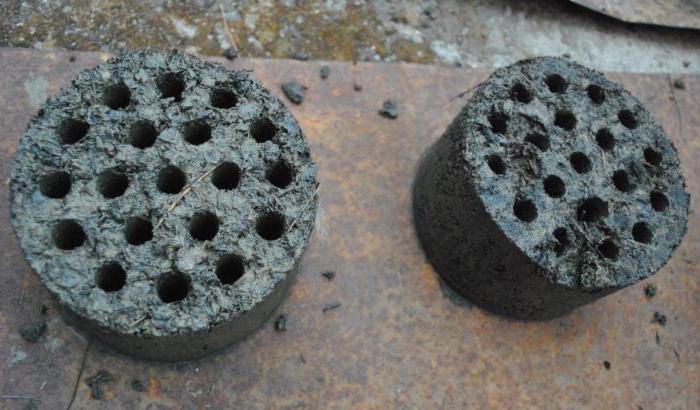

Pini-Kay fuel briquettes, reviews of which in most cases are only positive, differ in that they do not stain the surface that comes into contact with them during transportation and storage. High density can also be distinguished, which is equivalent to 1200 kg / cubic meter.
Ash content can reach 3%, which is one of the lowest indicators. If we additionally talk about density, then it is 2.5 times higher than this parameter inherent in wood. The bulk density of the material is 1000 kg / cubic meter. These figures are of interest to consumers quite often, buyers compare this figure with the bulk density, which is 300 kg / m3. This indicator, according to the owners of heating equipment, makes it easy to transport material over impressive distances. Due to the ideal shape, as well as small dimensions, it is possible to tightly stack briquettes on pallets, pouring, if necessary, through special sleeves. This makes it possible to fully automate the process of loading and unloading, as well as further combustion of this type of fuel.
Fuel briquettes "Pini-Kay", reviews of which you will know after reading the article, should be stored separately from other substances and materials. If the conditions are observed, the products can be stored indefinitely until the time of use. The temperature in the covered warehouse should be equal to the limit from +5 to +40 degrees. In this case, the relative humidity can vary from 30 to 80%. Interaction of products with water and aggressive substances should be excluded. Consumers claim that in order to extend the shelf life, exposure to ultraviolet radiation must also be excluded.
Manufacturing and assembly instructions
The order of operations in the manufacture of a press looks like this:
- It is necessary to weld the base of the device from the channels.
- From the corner we make 4 racks 1.5 meters long. They are welded vertically and at the same pitch.
- Further, it is necessary to make a drum from a pipe or sheet of tin, in which the raw materials will be mixed. If you have a broken washing machine, drum and bearings can be removed from it.
- The drum must be attached to the stands. If possible, it should be equipped with an electric motor. If the motor is too high-speed and it is not possible to reduce the speed of rotation of the drum to an acceptable value due to the difference in the diameters of the pulleys alone, a gearbox should be used.
- Under the drum, it is necessary to fix a tray through which the prepared material will be fed into the matrix.
- In the walls of the pipe used as a blank for the matrix, it is necessary to make several holes with a diameter of 3 - 5 mm. They must be distributed evenly so that air and water are squeezed out over the entire volume of the briquette.
- From below, a flange must be welded to the matrix, to which the removable bottom will be screwed. This bottom is cut from sheet steel in the form of a lugged disc.
- The die is welded or screwed to the base under the feed chute.
- Cut out a round punch from the steel sheet. It is simply a disc whose diameter allows it to freely enter the matrix.
The stem is made from a pipe: a diameter of 30 mm is sufficient. On one side, it is welded to the punch, and on the other, it is attached to the hydraulic unit.
We fix the receiving tray under the matrix
It is important to install in such a position that it does not interfere with the removal and installation of the removable bottom of the die. To reduce the time spent on removing the finished briquette from the die, and thereby make the machine more efficient, a spring with a disc of the same diameter as the punch.
To reduce the time spent on removing the finished briquette from the die, and thereby make the machine more productive, a spring with a disc of the same diameter as the punch can be welded to the bottom of the die.
After turning off the hydraulic system and removing the punch, the product will be pushed out by the spring automatically.
Reviews about RUF briquettes
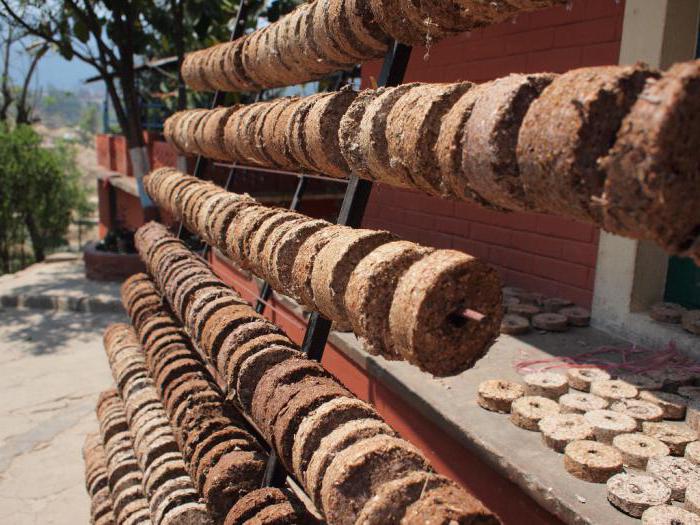

Fuel briquettes RUF, reviews of which correspond to the characteristics of the material, are easily decomposed. Owners of fireplaces, boilers, and stoves note that when using a different type of fuel, they have to turn into a stoker, ensuring that the fuel is put on every hour. In order to ensure smoldering, it is necessary to reduce the thrust by closing the blower. When melting the equipment, insignificant draft must be guaranteed, then a cold plug will be formed in the chimney, and the briquette will not smoke.
At the same time, it is possible to melt the device without preheating the air duct. Using RUF fuel briquettes, reviews of which it will be useful to read before visiting the store, you can warm up the room in a shorter time than using traditional firewood.
Equipment for the production of fuel briquettes
Large equipment in the "fuel" business cannot do without:
- shredder of raw materials;
- drying chamber;
- special press.
Note that there are 4 types of presses for the production of fuel briquettes:
- Hydraulic.
- Screw extruder.
- Shock mechanical.
Distinguish between their cost and principle of operation, combine - the requirements for raw materials (moisture content 4-10%) and uniform grinding (fractions less than 25x25x2 mm).
Each press has its own advantages and disadvantages for a home business:


The hydraulic press for the production of briquettes at home is a unit consisting of two parts: 1 mold; 2 hydraulic cylinder.
The principle of operation is similar to that of a jack. Raw material from sawdust is poured into the mold, and the hydraulic cylinder presses against the sawdust in the mold with a piston. Thus, a dense briquette is formed.
Advantages of a hydraulic press:
- the most affordable price;
- a simple and reliable device that practically does not have high wear units.
Minuses:
- poor performance.
- requires the preparation of raw materials with the addition of a binder.
For example, starch can be added as a binder for fuel briquettes: 2% -3% of the total mass. For the binder to work, of course, you need to moisten the mixture to 40%.)
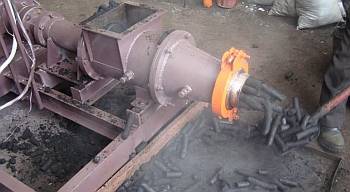

The screw press extruder for home production is similar in principle to a meat grinder. This type of press is described in detail in the article on the production of fuel pellets. The raw material is fed through the screw, which is compressed at the outlet through the die and compressed under high pressure.The whole process takes place under hot pressing. The die must be preheated, otherwise the device will jam. Under high temperature and pressure, hydrolytic lignin is released from sawdust. This is a combustible substance that also plays the role of a binder in the process of forming briquettes.
Pros of a screw extruder:
- the highest productivity (the weight of the process is carried out continuously by extrusion);
- in the process of pressing, ligin is released, which has a positive effect on the formation and quality of braces.
Minuses:
- the press requires a long preparation for work (it is required to warm up the die and the first briquettes are rejected);
- knots of increased friction quickly wear out - auger and a die;
- Due to the high operating temperatures (above 120Co) required for normal pressing of raw materials, irreversible processes occur, in which the quality of the product decreases (the calorie content of briquettes is lower).
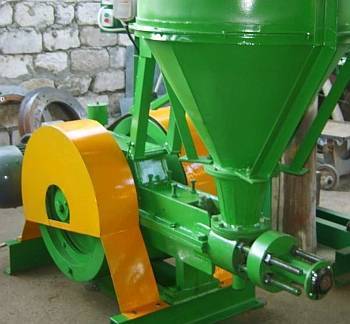

A mechanical shock press for the production of a fuel briquette is similar in principle to a perforator. Crank mechanisms (crankshaft, connecting rod and piston) transmits shocks to the piston at a given frequency (about 20 times per second). With the help of strokes of the piston, sawdust pre-loaded into the chamber is forced through the die.
Pros:
- briquettes can be made not only from sawdust, but also from other materials: grinding and coal dust, peat, straw, MFD waste;
- allows the production of briquettes for various purposes - for the private market and for industrial needs;
- simplicity of the mechanism and the ability to work for a long time without human intervention are the main advantages of a shock-mechanical press;
- the unit has good performance;
- the value of the equipment utilization factor is 0.9.
- the highest price;
- rapid wear of the friction units of the crank (2 forces act on them at once: impact force and friction).
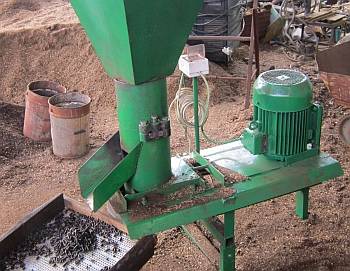

A pellet mill is the same feed pellet mill, into which sawdust is poured instead of grain.
Pros: Good price / performance ratio.
Minuses:
- only small fraction briquettes can be produced;
- finer grinding of raw materials is required;
- requires the preparation of raw materials with the addition of a binder for dense briquetting (starch 2% -3%).
In the complete set of the line, along with the press, there are often various devices that allow you to improve the final product:
- mixers for mixing impurities (for example, lignin);
- nozzles for cutting certain shapes of briquettes;
- moisturizers for overdried raw materials.
Some equipment and even some presses can be made by hand.
Features of using briquettes "RUF"
Fuel briquettes "RUF", reviews of which it will be useful to read any owner of heating equipment that requires ignition, differ in certain characteristics. For example, knowing that the heat transfer is 4500 kcal / kg, you can heat a house with an area of 45 square meters for one hour using one briquette. The weight of the latter should be one kilogram. Thus, to obtain 10,000 kcal, it will be necessary to use 5 tons of firewood, of which almost half will be with water. To obtain an equivalent amount of heat, you will need to use briquettes in a volume that varies from 1.5 to 2.2 tons. In view of all of the above characteristics, it can be noted that storage and transportation of briquettes will require an area 2 times smaller than that which would be required for the same purposes with the use of ordinary firewood. This indicates that the consumer of briquettes benefits more and gets more efficiency than buying and shipping conventional firewood.
If we compare it with coal, then to obtain heat of 10,000 kcal, it will be necessary to use the mentioned fuel in the amount of 2.2 tons.
The specifics of the production of briquettes for heating
Fuel briquette extruder
The peculiarity of the manufacture of eurodrops is the use of waste from the woodworking industry, agriculture and coal mining. The production of briquettes for heating can be organized on the basis of any of the above-described enterprises.
For manufacturing, it is necessary to choose the right source material. Correct production of briquettes for heating starts from the preparatory stage. Depending on the available raw material base, several types of materials are distinguished:
- Agricultural waste - seed husks, straw. The first has the highest energy capacity. However, it is also characterized by a high purchase cost;
- Wood sawdust. The most suitable option, since it is from them that briquettes for heating with their own hands are most often made;
- Peat. Needs a complex preparatory process, since it initially has high humidity;
- Coal. In fact, so-called coal dust is used, which is a by-product of mining.
Preparation of raw materials includes preliminary grinding and further drying. This is necessary to reduce humidity, since heating with sawdust briquettes will be beneficial only when the water content is no more than 10% of the total volume. Then, fixers and modifiers can be added to the resulting material to increase heat transfer.
For full-fledged production, in addition to a press (extruder), you will need a mechanism for packing briquettes.
Types of briquettes for heating
Briquette press RUF
In fact, Eurowood differs not only in the raw material, but also in the way it is processed. The simplest manufacturing method is pressing. For the production of briquettes for heating RUF, a special belt press of the RUF company of the same name is required. It was from him that the name of this type of Eurodrops originated.
The advantage of this process is the speed of manufacture. Pre-prepared raw materials are loaded into the receiving chamber, and then, with the help of augers, enters the pressing zone. Those. in fact, the production of briquettes of this type requires a minimum of investment and effort.
However, the final product has a number of features:
- Almost all reviews of peat briquettes for heating note their susceptibility to moisture absorption. Therefore, you need to take care of the appropriate storage location;
- Eurowood made with original equipment has a letter imprint on the surface. In most cases, this indicates compliance with the manufacturing technology. But it all depends on the quality of the feedstock.
It is best to choose a different production method to improve performance. Peat briquettes for heating, in addition to pressing, undergo a surface firing stage. In this way, a moisture-resistant outer shell is formed, which furthermore contributes to the improvement of the mechanical resistance.
Extruder Pini Kay
Additionally, the equipment has a heating zone that is located around the feeding pressing auger. This manufacturing technology is called Pini Kay. Its peculiarity is its relatively low productivity in comparison with RUF. However, pine kei wood briquettes have a much longer shelf life. In addition, their increased density has a positive effect on heat transfer.
This type of Eurodrops is characterized by the following qualities:
- Convenient form for loading into the boiler combustion chamber;
- The ability to burn for a long time.
However, the production process does not always follow the technology. This applies in particular to the quality of the external firing and the quality of the pressing. In most cases, the specific gravity of a coal briquette for heating may differ.
The color of Eurowood depends on the original material of manufacture. For peat briquettes for heating, it will be dark brown or black. RUF made from sawdust on a press have a white or light yellow tint.
Additional features of RUF briquettes
In shape, these products resemble bricks, in the manufacture of which minimum requirements are imposed on the qualifications of personnel and the organization of production, which favorably affects the cost of the product. Among the minuses, one can single out the least resistance among all other briquettes to moisture and external mechanical stress. Therefore, for this brand of fuel, high-quality packaging is required; if it is damaged, long-term transportation and storage becomes impossible. This is especially true for the CIS roads, the level of which does not correspond to the European level.
Description of the process of making briquettes
The whole process is reduced to the sequential performance of the following operations:
- Preparation of raw materials for briquetting (each point is performed if necessary):
- crushing of raw materials into small fractions;
- drying of crushed raw materials;
- crushing of dried raw materials.
- For the DIY option:
- mixing the prepared raw materials with a binding link, for example, with clay;
- mixing the resulting mixture with water until a homogeneous mass is formed.
- Loading raw materials into briquetting equipment.
- Pressing the prepared raw material and shaping it.
- Drying in the sun (do it yourself).
- Packing and packaging of products.
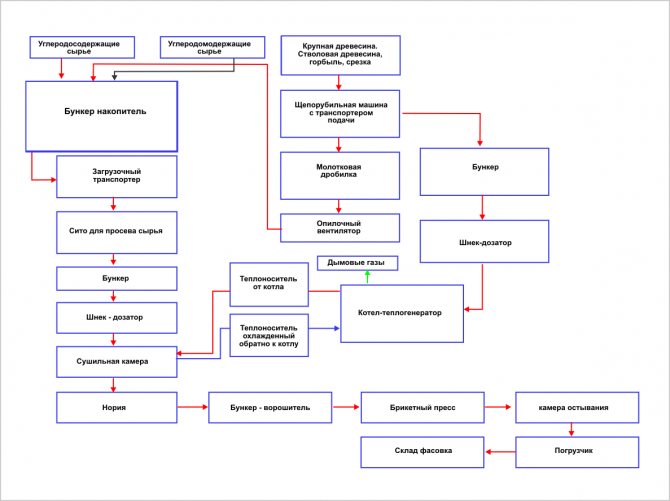

Briquetting process flow diagram
Features of industrial production
In industrial production, 3 technologies for pressing fuel briquettes are used:
- under high pressure on hydraulic presses - at the exit, briquettes are obtained in the form of a small brick;
- under high pressure on shock-mechanical and hydraulic presses - at the exit, briquettes are obtained in the form of a cylinder;
- pressing under the influence of heat treatment and high pressure on screw (mechanical) presses - at the outlet, briquettes are obtained in the form of a hollow polyhedron.
As a result of pressing, lignin is released from the wood, which acts as a binder to form a dense, homogeneous briquette structure.
Video: production of briquettes on an industrial scale
Buffer tank for solid fuel boilers: device description, purpose, connection. Review of popular models and advice to buyers.
Learn about the classification of double-circuit solid fuel boilers, about the options for connecting to the system and how to increase the heat transfer of the boiler.
What is the difference between a two-pipe water heating system and a one-pipe one https://teplius.ru/sistemy/vidy/dvuhtrubnaya.html
Reviews about briquettes "Nestro"
Fuel briquettes "Nestro", reviews of which will become known to you, if you read the information below, has a wide area of use. They are used when it is necessary to operate industrial equipment, as well as in railway transport. The bars can have an 8-sided shape with a hole that is located inside. The length of the product is 250 millimeters, while the cross-section is square, and has a side within 65 millimeters. The diameter of the circle is equivalent to 70 millimeters, and the hole has a diameter equal to 20 mm. The moisture content of the product on delivery should not exceed 9%, while the maximum value varies within 7%. The ash content is minimal and amounts to 0.5%.
Consumers like the presence of a technological hole inside the product, which contributes to more intense combustion, while forced ventilation is not required. This makes it possible to use fuel in equipment that is characterized by low thrust. Products are manufactured using the technology of shock-mechanical pressing of husks and sawdust.The main difference between such briquettes is the lack of processing under the influence of temperature during pressing. If there is a need to use briquettes of a certain shape, then these requirements can be taken into account by the manufacturer.
Manufacturing is carried out using connecting rod mechanical or hydraulic presses. Fuel quite often has a cylindrical shape, and among the negative and positive characteristics, the same features can be distinguished that are inherent in RUF materials. The cost of such products is relatively low due to the fact that the production process is inexpensive. Consumers note that in terms of technical features, these briquettes are inferior in many qualities to Pini & Kay fuel.
What properties does sunflower husk have?
Husk is not a waste, but a valuable resource of sunflower crops, which is effectively used in the garden. Due to the presence of valuable components, the husk of sunflower seeds increases the quality of the crop. According to its characteristics, it resembles:
- sawdust and wood shavings;
- bark of trees;
- buckwheat husk;
- birch bark crust;
- wheat husk;
- processed products of nuts.
The main component of the material is cellulose, so it is suitable for mulching. Gardeners use organic waste to saturate the soil with useful elements and protect the planting from parasites. Studies have shown that the use of sunflower seed peels increases yields by 20%, therefore, sunflower husks are often used as fertilizer in household plots.
It takes several years for cellulose to decompose. During the period of complete decay, it is able to extract nitrogen compounds from the soil. Efficiency is increased by combining the material with manure, because the latter contains large amounts of nitrogen. This is a great option for feeding the land.


Features of sawdust fuel at home
It is often not profitable to use waste from the wood industry for heating in its pure form. Sawdust waste quickly burns out in the furnace, emitting little heat, but a lot of ash. You can make fuel more efficient with briquettes.
Features of briquetting:
- Briquettes are produced by the release of lignin. This is only possible with industrial machines. At home, a sticky substance is simply added to the raw materials, which helps to glue the sawdust and shape them.
- You should consider in advance the options for where the fuel will be dried and stored. It should be a spacious room, protected from precipitation.
A shredder may be needed to prepare briquettes. The finer the particles, the denser the briquettes will be. Equipment that softens the raw material for composting can be used.
You will need a manual or hydraulic press to work. There should also be containers for pressing. A container for mixing raw materials, a mixer or a concrete mixer should be provided.
